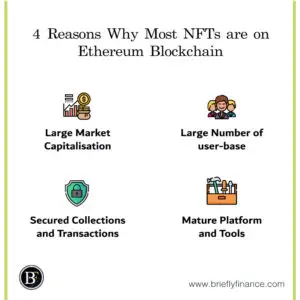In general, most of the Non-Fungible Tokens (NFTs) have been listed on the Ethereum blockchain network. Despite the fact that Ethereum network charges more gas fees and the transactions are slower. But somehow users still prefer it.
Ethereum is leading the demand and sales volume of NFTs in the field. In this post, let us discuss why…
NFTs are mostly in the Ethereum blockchain because of its large market capitalisation and user-base, security, and mature platform and tools.

Attribution: The icons has been designed using resources from Flaticon.com
Large Market Capitalisation
With a market capitalisation of $360 Billion Ethereum is 10x more than most NFT related tokens. Given that it has been established and adopted earlier than its peers which made it larger in size and more reliable to be associated with.
As of 6th February 2022 the market capitalisation for the below blockchains as follows:
- Ethereum $360,239,211,371
- Solana $36,311,255,296
- Cardano $38,056,848,069
- Avalanche $19,069,072,963
As you can see above, the Ethereum network is much larger than its peers. And cause NFTs are already risky, users prefer to reduce this risk through participating in a well-established network with more money invested in it.
Large Number of user-base
To be in the NFT space you will require to overcome a learning curve, first you will need to buy your first cryptocurrency through an exchange, then have a wallet like Metamask to make it easier to buy NFTs, and then connecting your wallet and dealing with the gas fees and signing contracts.
With such difficult entry point, the users will eventually prefer to use a platform where their friends/family recommend and are familiar with, which turn out to be the Ethereum NFT platforms.
Ethereum is already ahead and other platforms need time for users to adopt and catch up. For example, the number Ethereum NFTs user base are 344,349 unique buyers with sale volume of $3 billion and in comparison the number of Solana’s NFT users are 23,413 unique buyers with $190 million in sale volume (source: as of January 2022, Cryptoslam).
Secured Collections and Transactions
As a framework, the tokens (cryptocurrencies/NFTs) are decentralised which means that their transactions activity are based on a consensus mechanism which means there is no one owner (central authority) to verify a transaction but they are group of entities approving it (multiple computers/stakers around the world).
I don’t want to get technical in this post, but if you are interested check out this article about the proof-of-work and proof-of-stake mechanism that are used for Ethereum network and its peers..
Now having said that, the larger the network the more validators are there to approve a transaction the harder it is for a hacker to hack a network. Ethereum has much more validators compared to its peers leading to a less likelihood that NFTs issued in this network will be hacked/disappear.
Mature Platform and Tools
Because the Ethereum platform is well-established, so is the tools and facilities associated with it which accelerates stronger demand.
As referenced in Forbes:
According to Bas Roos, CEO of peer-to-peer food and beverage marketplace Bistroo, Ethereum will continue to dominate the DeFi landscape in the short term, “With the EVM (Ethereum Virtual Machine) becoming more and more the standard within dApp and smart contract development, Solidity-based applications will take the stage, paving the way for future Web 3.0 business models.
Here are some examples of platforms/tools that I think are well-developed specifically for Ethereum:
- Metamask has been one of the well known wallets that been developed really well. Its compatibility with Ethereum makes it easy and convenient to use.
- Marketplaces like LooksRare a community-first driven market place is easy to use and navigate while continuously adopting to users needs.
- Established Metaverses like Sandbox and Decentraland that been on the works for long time now, and associated projects who been preparing their avatars and content related to their users on these Metaverses which only work for Ethereum network. (I am sure this is not the only utility that has took much time to develop on Ethereum, there is also much more.)
Due to these reasons it is harder for competitors to catch up and build better platforms for creators.
Final Thoughts
Despite the high gas fees that comes along with it. As of now Ethereum is still the leader, but we do not know who could be in the future. This space moves really fast and the potential for changes is big.
Related Posts:
- Why are NFTs Expensive? 7 Reasons that Makes NFTs Valuable
- What NFTs Should I buy? a Comprehensive Guide
- Is NFT a Cryptocurrency? NFTs vs. Cryptocurrencies Explained
Disclaimer: Above links are affiliate links and at no additional cost to you. I may earn a commission. Know that I only recommend products, tools, services and learning resources I’ve personally used and believe are genuinely helpful and relevant. It is not because of the small commissions I make if you decide to purchase them. Most of all, I would never advocate for buying something that you can’t afford or that you’re not yet ready to implement.
